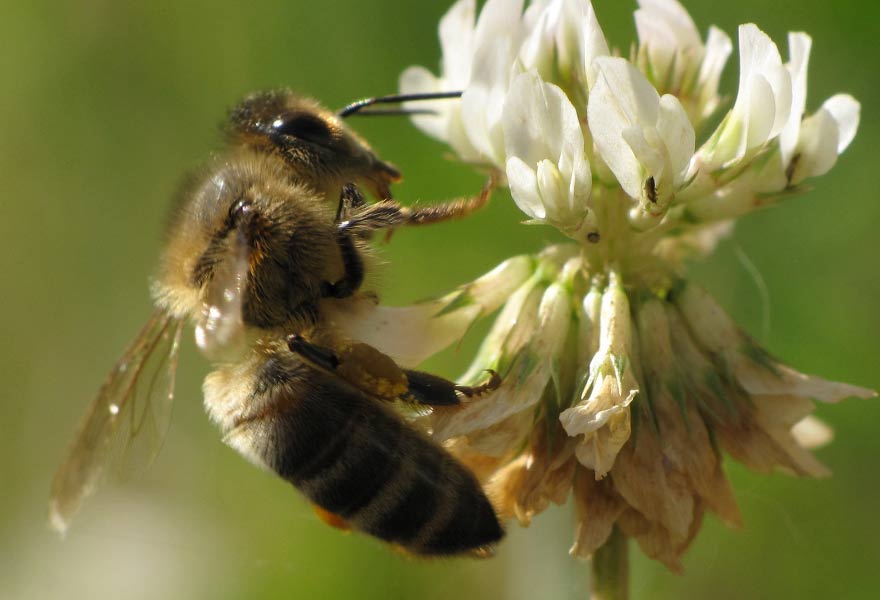Le déclin des abeilles expliqué en 3 minutes par lemondefr
Un rapport d’expertise rendu public mercredi 26 août par l’Autorité européenne de sécurité des aliments (EFSA) affirme que les trois principales molécules (clothianidine, thiaméthoxame et imidaclopride) de la famille des néonicotinoïdes représentent « des risques élevés » pour les abeilles, même si elles sont utilisées en simple pulvérisation.
Au printemps 2013, la même agence EFSA avait conduit l’Union européenne à mettre en place un moratoire de deux ans sur certaines utilisations « systémiques » de ces molécules ; moratoire limité au maïs, tournesol et colza. L’interdiction ne touchait pas les traitements systémiques utilisés en pulvérisation sur certaines cultures comme les céréales.
La nouvelle mise en garde de l’EFA va donc aujourd’hui plus loin, confirmant le rôle des néonicotinoides sur le déclin des abeilles, et par conséquent, celui de l’agriculture. Cette expertise devrait conduire l’Union européenne à étendre l’interdiction à tous les usages de ces substances pesticides. C’est un enjeu de sécurité alimentaire majeur, d’autant que des alternatives viables et non chimiques existent et devraient être encouragées encore plus largement.
La partie est loin d’être gagnée car en dépit des risques avérés sur les abeilles, Bruxelles peut céder à la pression des lobbies agrochimiques et remettre en circulation ou autoriser certaines substances. Elle l’a déjà fait récemment puisque fin juillet elle a autorisé a mise sur le marché d’un nouvel insecticide neurotoxique, le sulfoxaflor, développé par le géant Dow Agrosciences malgré les réticences de l’EFSA et la colère des organisations apicoles et des ONG comme Greenpeace.
La disparition des abeilles
On l’appelle « syndrome d’effondrement des colonies d’abeilles » ou CCD (« Colony Collapse Disorder »). Ce phénomène de mortalité est anormal et récurrent notamment en France et dans le reste de l’Europe, depuis 1981.
Ce phénomène affecte par contrecoup la production apicole dans une grande partie du monde où cette espèce a été introduite. Il prend la forme de ruches subitement vidées de presque toutes leurs abeilles, généralement à la sortie de l’hiver, plus rarement en pleine saison de butinage. Aux États-Unis, près de 25 % du cheptel a disparu au cours de l’hiver 2006-2007. De nombreux pays européens sont touchés depuis le début des années 2000. Les pertes peuvent atteindre, localement, jusqu’à 90 % des colonies. Les taux de mortalité hivernale des ruches d’abeilles domestiques, mesurés depuis l’apparition du phénomène sont quasi systématiquement supérieurs aux taux, d’environ 10 %, observés auparavant.
Ce syndrome est jugé très préoccupant par les apiculteurs, mais aussi par de nombreux écologues, économistes et experts en raison de l’importance économique et écologique de l’abeille en tant que pollinisatrice.
Selon l’INRA, la production de 84 % des espèces cultivées en Europe dépend directement des pollinisateurs, qui sont à plus de 90 % des abeilles domestiques et sauvages. Les services rendus à la pollinisation par les abeilles sont estimés à environ quinze milliards de dollars par an aux États-Unis.
Ce phénomène épidémique fait l’objet de polémiques scientifiques et médiatiques. Les chercheurs étudiant ce phénomène ne pouvaient s’appuyer que sur un corpus très pauvre d’études et de données, notamment écoépidémiologiques et génétiques. Depuis le milieu des années 2000 de nombreux travaux ont été publiés, ce qui a permis la constitution d’une bibliographie de plus en plus solide. Des avancées considérables ont été réalisées, notamment l’identification correcte des agents chimiques et des bio-agresseurs impliqués dans le phénomène ainsi que la mise en évidence d’effets synergiques divers.
S’abonner
Connexion
0 Commentaires
Inline Feedbacks
View all comments










